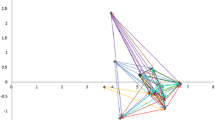Abstract
Reduction of excessive carbon emissions (CEs) is an acute challenge faced by manufacturing companies in operation of their Reverse Logistics (RL) networks, specifically in the developing nations. Hence, companies are realizing the importance of examining the carbon footprint across the network and attaining significant reduction through refurbishing, repair and recycling of their end of use and end of life products. This research contributes to the area of modeling reverse logistic network design problems, by developing a bi-objective optimization model under carbon tax scheme, for integrating strategic decision making at the design phase of the RL network. The carbon emissions due to each of the operational activities are considered and their corresponding costs along with investment in technology are also embedded in the model. The objectives of the model are: (1) profit maximization (2) carbon emissions minimization. The RL network design is configured as a mixed-integer programming problem model and fuzzy programming is utilized as solution methodology for obtaining a trade-off solution. A case of an Indian electrical and electronics remanufacturer is considered. The results furnishes valuable managerial and policy insights; (i) impacts of carbon tax on the strategic level of RL from an emerging economy perspective, (ii) optimal carbon price for maximum carbon emissions reductions per dollar increase in the total cost.
Access this chapter
Tax calculation will be finalised at checkout
Purchases are for personal use only
Similar content being viewed by others
References
Zhou X, Wei X, Lin J, Tian X, Lev B, Wang S (2020) Supply chain management under carbon taxes: a review and bibliometric analysis. Omega, 102295
Hu X, Yang Z, Sun J, Zhang Y (2020) Carbon tax or cap-and-trade: which is more viable for Chinese remanufacturing industry? J Clean Prod 243:
Haites E (2018) Carbon taxes and greenhouse gas emissions trading systems: what have we learned? Clim Policy 18(8):955–966
John ST, Sridharan R, Kumar PR (2018) Reverse logistics network design: a case of mobile phones and digital cameras. Int J Adv Manuf Technol 94(1–4):615–631
Fahimnia B, Sarkis J, Choudhary A, Eshragh A (2015) Tactical supply chain planning under a carbon tax policy scheme: a case study. Int J Prod Econ 164:206–215
Waltho C, Elhedhli S, Gzara F (2019) Green supply chain network design: a review focused on policy adoption and emission quantification. Int J Prod Econ 208:305–318
Diener DL, Tillman AM (2015) Component end-of-life management: exploring opportunities and related benefits of remanufacturing and functional recycling. Resour Conserv Recycl 102:80–93
Dat LQ, Linh DTT, Chou SY, Vincent FY (2012) Optimizing reverse logistic costs for recycling end-of-life electrical and electronic products. Expert Syst Appl 39(7):6380–6387
Zarbakhshnia N, Soleimani H, Goh M, Razavi SS (2019) A novel multi-objective model for green forward and reverse logistics network design. J Clean Prod 208:1304–1316
Demir E, Bektaş T, Laporte G (2014) A review of recent research on green road freight transportation. Eur J Oper Res 237(3):775–793
Halldórsson Á, Sundgren C, Wehner J (2019) Sustainable supply chains and energy: where ‘planet’ meets ‘profit’. Edward Elgar Publishing, In Handbook on the Sustainable Supply Chain
Zarbakhshnia N, Jaghdani TJ (2018) Sustainable supplier evaluation and selection with a novel two-stage DEA model in the presence of uncontrollable inputs and undesirable outputs: a plastic case study. Int J Adv Manuf Technol 97(5–8):2933–2945
Su CM, Horng DJ, Tseng ML, Chiu AS, Wu KJ, Chen HP (2016) Improving sustainable supply chain management using a novel hierarchical grey-DEMATEL approach. J Clean Prod 134:469–481
Özceylan E, Demirel N, Çetinkaya C, Demirel E (2017) A closed-loop supply chain network design for automotive industry in Turkey. Comput Ind Eng 113:727–745
Kuşakcı AO, Ayvaz B, Cin E, Aydın N (2019) Optimization of reverse logistics network of End of Life Vehicles under fuzzy supply: a case study for Istanbul Metropolitan Area. J Clean Prod 215:1036–1051
Reddy KN, Kumar A, Sarkis J, Tiwari MK (2020) Effect of carbon tax on reverse logistics network design. Comput Ind Eng 139:
Chai Q, Xiao Z, Lai KH, Zhou G (2018) Can carbon cap and trade mechanism be beneficial for remanufacturing? Int J Prod Econ 203:311–321
Yu M, Cruz JM (2019) The sustainable supply chain network competition with environmental tax policies. Int J Prod Econ 217:218–231
Tosarkani BM, Amin SH, Zolfagharinia H (2020) A scenario-based robust possibilistic model for a multi-objective electronic reverse logistics network. Int J Prod Econ 224:
John ST, Sridharan R, Kumar PR (2017) Multi-period reverse logistics network design with emission cost. Int J Logist Manag
Author information
Authors and Affiliations
Editor information
Editors and Affiliations
Rights and permissions
Copyright information
© 2021 The Author(s), under exclusive license to Springer Nature Singapore Pte Ltd.
About this paper
Cite this paper
Solanki, R., Darbari, J.D. (2021). A Multi Objective Reverse Logistics Network Design Model Under Carbon Pricing: An Emerging Economy Perspective. In: Tiwari, A., Ahuja, K., Yadav, A., Bansal, J.C., Deep, K., Nagar, A.K. (eds) Soft Computing for Problem Solving. Advances in Intelligent Systems and Computing, vol 1393. Springer, Singapore. https://doi.org/10.1007/978-981-16-2712-5_47
Download citation
DOI: https://doi.org/10.1007/978-981-16-2712-5_47
Published:
Publisher Name: Springer, Singapore
Print ISBN: 978-981-16-2711-8
Online ISBN: 978-981-16-2712-5
eBook Packages: Intelligent Technologies and RoboticsIntelligent Technologies and Robotics (R0)




